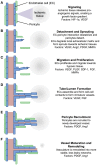Depot-Based Delivery Systems for Pro-Angiogenic Peptides: A Review
- PMID: 26236708
- PMCID: PMC4504170
- DOI: 10.3389/fbioe.2015.00102
Depot-Based Delivery Systems for Pro-Angiogenic Peptides: A Review
Abstract
Insufficient vascularization currently limits the size and complexity for all tissue engineering approaches. Additionally, increasing or re-initiating blood flow is the first step toward restoration of ischemic tissue homeostasis. However, no FDA-approved pro-angiogenic treatments exist, despite the many pre-clinical approaches that have been developed. The relatively small size of peptides gives advantages over protein-based treatments, specifically with respect to synthesis and stability. While many pro-angiogenic peptides have been identified and shown promising results in vitro and in vivo, the majority of biomaterials developed for pro-angiogenic drug delivery focus on protein delivery. This narrow focus limits pro-angiogenic therapeutics as peptides, similar to proteins, suffer from poor pharmacokinetics in vivo, necessitating the development of controlled release systems. This review discusses pro-angiogenic peptides and the biomaterials delivery systems that have been developed, or that could easily be adapted for peptide delivery, with a particular focus on depot-based delivery systems.
Keywords: angiogenesis; biomaterials; controlled release; depot-based; drug delivery; hydrogels; review.
Figures


Similar articles
-
Enzymatically-responsive pro-angiogenic peptide-releasing poly(ethylene glycol) hydrogels promote vascularization in vivo.J Control Release. 2015 Nov 10;217:191-201. doi: 10.1016/j.jconrel.2015.09.005. Epub 2015 Sep 11. J Control Release. 2015. PMID: 26365781 Free PMC article.
-
Engineered systems for therapeutic angiogenesis.Curr Opin Pharmacol. 2017 Oct;36:34-43. doi: 10.1016/j.coph.2017.07.002. Epub 2017 Aug 12. Curr Opin Pharmacol. 2017. PMID: 28806581 Review.
-
Injectable and tunable hyaluronic acid hydrogels releasing chemotactic and angiogenic growth factors for endodontic regeneration.Acta Biomater. 2018 Sep 1;77:155-171. doi: 10.1016/j.actbio.2018.07.035. Epub 2018 Jul 18. Acta Biomater. 2018. PMID: 30031163
-
Pro-angiogenic peptides in biomedicine.Arch Biochem Biophys. 2018 Dec 15;660:72-86. doi: 10.1016/j.abb.2018.10.010. Epub 2018 Oct 15. Arch Biochem Biophys. 2018. PMID: 30336134 Review.
-
Vesicular phospholipid gels as drug delivery systems for small molecular weight drugs, peptides and proteins: State of the art review.Int J Pharm. 2019 Feb 25;557:1-8. doi: 10.1016/j.ijpharm.2018.12.030. Epub 2018 Dec 18. Int J Pharm. 2019. PMID: 30572079 Review.
Cited by
-
Gold nanoparticles and angiogenesis: molecular mechanisms and biomedical applications.Int J Nanomedicine. 2019 Sep 19;14:7643-7663. doi: 10.2147/IJN.S223941. eCollection 2019. Int J Nanomedicine. 2019. PMID: 31571869 Free PMC article. Review.
-
Development of L-Lysine-Loaded PLGA Microparticles as a Controlled Release System for Angiogenesis Enhancement.Pharmaceutics. 2023 Feb 1;15(2):479. doi: 10.3390/pharmaceutics15020479. Pharmaceutics. 2023. PMID: 36839801 Free PMC article.
-
Microchannel network hydrogel induced ischemic blood perfusion connection.Nat Commun. 2020 Jan 30;11(1):615. doi: 10.1038/s41467-020-14480-0. Nat Commun. 2020. PMID: 32001693 Free PMC article.
-
Macroporous Dual-compartment Hydrogels for Minimally Invasive Transplantation of Primary Human Hepatocytes.Transplantation. 2018 Sep;102(9):e373-e381. doi: 10.1097/TP.0000000000002330. Transplantation. 2018. PMID: 29916986 Free PMC article.
-
The role of SUMOylation in the neurovascular dysfunction after acquired brain injury.Front Pharmacol. 2023 Mar 22;14:1125662. doi: 10.3389/fphar.2023.1125662. eCollection 2023. Front Pharmacol. 2023. PMID: 37033632 Free PMC article. Review.
References
-
- Aachmann F. L., Larsen K. L., Wimmer R. (2012). Interactions of cyclodextrins with aromatic amino acids: a basis for protein interactions. J. Incl. Phenom. Macrocycl. Chem. 73, 349–357.10.1007/s10847-011-0071-y - DOI
-
- Akeson A. L., Woods C. W., Hsieh L. C., Bohnke R. A., Ackermann B. L., Chan K. Y., et al. (1996). AF12198, a novel low molecular weight antagonist, selectively binds the human type I interleukin (IL)-1 receptor and blocks in vivo responses to IL-1. J. Biol. Chem. 271, 30517–30523.10.1074/jbc.271.48.30517 - DOI - PubMed
Publication types
Grants and funding
LinkOut - more resources
Full Text Sources
Other Literature Sources

